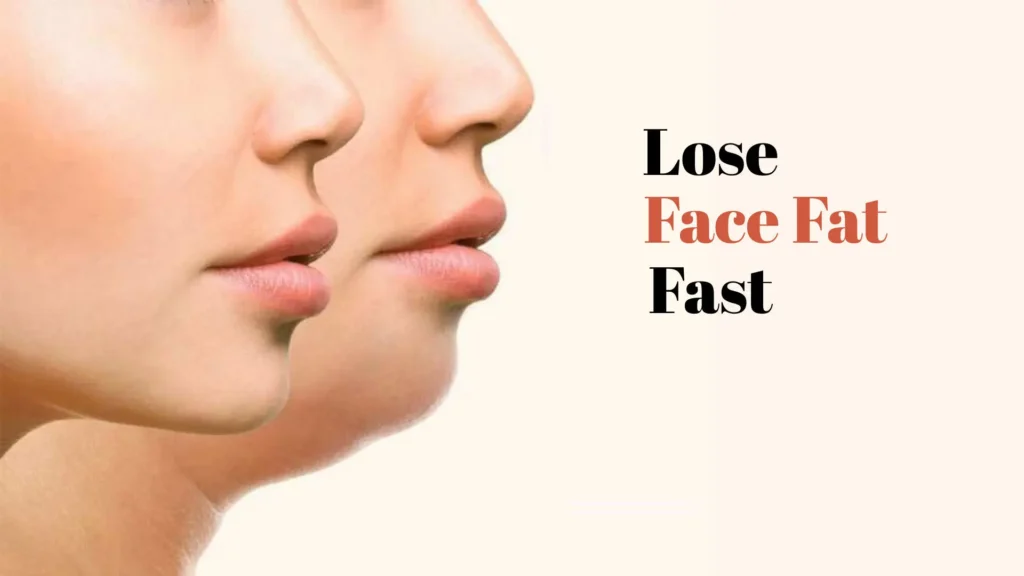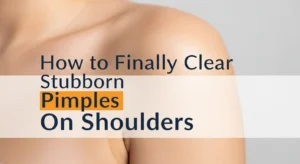Do you ever look in the mirror and wish your face looked more defined? Many people feel self-conscious about extra fullness in their cheeks or a double chin. While you can't magically “spot reduce” fat from just your face, there are effective ways to lose face fat by reducing overall body fat. Additionally, certain habits can help minimize puffiness and tone facial muscles, giving you a more sculpted appearance.

This article will break down easy-to-follow steps you can take to lose face fat, focusing on healthy habits that benefit your whole body. Get ready to discover how small changes can make a big difference!
🌟 Daily Face Fat Loss Habit Tracker 🌟
Check off these simple habits each day to help you on your journey to a slimmer face!
Key Takeaways
- Overall Weight Loss is Key: Losing fat from your entire body is the most effective way to lose face fat.
- Diet Matters Most: Eating whole foods, cutting down on sugar and processed items, and watching your salt intake can greatly reduce facial puffiness.
- Stay Hydrated & Sleep Well: Drinking enough water and getting quality sleep are crucial for reducing water retention and inflammation in your face.
- Facial Exercises Can Help Tone: While they don't burn fat, specific face exercises can strengthen facial muscles, making your face look firmer and more defined.
- Patience & Consistency: Achieving a slimmer face takes time and consistent effort. Stick with healthy habits, and you'll see results!
Understanding Face Fat: Why Is It There?
Before we talk about how to lose face fat, it's helpful to understand why some people have more fat on their faces than others. It's not just about how much you weigh!
Several things can cause a fuller face:
- Overall Body Fat: This is the most common reason. When your body stores extra fat, it stores it everywhere, including your face, neck, and chin area. So, if you're carrying extra weight overall, your face will likely show it.
- Genetics: Sometimes, it's just how you're built. Your genes can decide where your body tends to store fat or how your facial structure naturally looks.
- Water Retention: Also called “edema,” this is when your body holds onto too much water. Eating too much salt, not drinking enough water, or even certain health conditions can cause your face to look puffy.
- Age: As we get older, our skin can lose its firmness, and the fat pads in our face can shift, sometimes making the face look fuller or less defined.
- Lifestyle Habits: Poor sleep, high stress, too much alcohol, and an unhealthy diet can all contribute to a bloated or puffy face.
- Medical Conditions or Medications: In some cases, certain health issues or medicines can lead to facial swelling or weight gain. If you're concerned, it's always a good idea to talk to a doctor.
The good news is that for most people, making smart changes to their diet and lifestyle can make a big difference in how their face looks.

The Big Picture: Overall Weight Loss
The most effective way to lose face fat is to lose fat from your entire body. Think of your body as one system: when you reduce your overall body fat, your face will naturally become leaner too. This means focusing on a healthy diet and regular exercise.
1. Create a Calorie Deficit
This might sound complicated, but it's simple: you need to burn more calories than you eat. Your body uses calories for energy. If you eat more calories than you use, your body stores the extra as fat. If you eat fewer calories than you use, your body starts to burn stored fat for energy.
- How to do it: You don't need to starve yourself! Start by making small changes. For example, swap sugary drinks for water, choose smaller portions, and pick healthy snacks.
- Tip: Use online calculators to estimate how many calories your body needs each day. Then, aim to eat about 300-500 fewer calories than that to lose weight safely.
2. Embrace a Balanced Diet
What you eat plays a huge role in your weight and how your face looks. Focus on whole, unprocessed foods.
- Lean Proteins: Foods like chicken, fish, beans, and lentils help you feel full and keep your muscles strong. They also help your body burn more calories.
- Plenty of Fruits and Vegetables: These are packed with vitamins, minerals, and fiber, but have few calories. They help you feel full without adding extra pounds. Aim for a variety of colors!
- Whole Grains: Choose brown rice, whole wheat bread, and oats instead of white bread and sugary cereals. They provide lasting energy and help with digestion.
- Healthy Fats: Don't be afraid of fats! Avocados, nuts, seeds, and olive oil are good for you in moderation. They help your body absorb vitamins and can keep you feeling satisfied.
Foods to Limit or Avoid:
- Processed Foods: These are often high in unhealthy fats, sugar, and salt (like chips, fast food, frozen dinners). They can cause inflammation and water retention.
- Sugary Drinks: Sodas, fruit juices (with added sugar), and energy drinks are full of empty calories that don't fill you up.
- Excess Sugar: Candies, pastries, and desserts contribute to fat storage and can make your skin look dull.
- Unhealthy Fats: Fried foods and foods with trans fats (often found in baked goods and fast food) can increase overall body fat.
💡 Pull Quote: “Your kitchen is where weight loss truly begins. Fuel your body with nourishing foods, and your face will reflect that healthy glow!”
3. Stay Hydrated
It might seem strange, but drinking more water can actually help reduce puffiness in your face. When you don't drink enough water, your body holds onto the water it has, leading to bloating and a puffy look, especially in your face.
- How much? Aim for at least 8 glasses (about 2 liters) of water a day. If you're active or it's hot, you might need more.
- Benefits:
- Flushes out excess sodium (salt), which causes water retention.
- Helps your metabolism work better.
- Keeps your skin looking healthy and plump (in a good way!).
- Can help you feel full, so you eat less.
4. Get Enough Sleep
Sleep is super important for your body, including your weight. When you don't get enough sleep, your body makes more of a stress hormone called cortisol. High cortisol levels can lead to weight gain, especially around your middle, and can also make your face look puffy.
- Aim for: 7-9 hours of quality sleep each night.
- Tips for better sleep:
- Go to bed and wake up at the same time each day.
- Make your bedroom dark, quiet, and cool.
- Avoid screens (phones, tablets, TV) right before bed.
- Limit caffeine and heavy meals in the evening.
5. Manage Your Stress
Chronic stress can hinder your efforts to lose face fat by causing your body to release cortisol. This hormone can increase your appetite, trigger cravings for unhealthy foods, and promote fat storage.
- Find ways to relax: Try meditation, yoga, deep breathing exercises, spending time in nature, or hobbies you enjoy.
- Take breaks: Even short breaks during a busy day can help reduce stress levels.
Targeting Face Fat (Indirectly)
While you cannot spot-reduce, certain specific actions can help you lose face fat by reducing puffiness and improving the definition of your facial features.
1. Reduce Sodium (Salt) Intake
Eating too much salt is a major cause of water retention, which can make your face look swollen and bloated.
- Check food labels: Many processed foods, canned soups, and fast foods are very high in sodium.
- Cook at home: This gives you control over how much salt goes into your meals.
- Use herbs and spices: Flavor your food with delicious herbs and spices instead of relying on salt.
- Be careful with condiments: Soy sauce, ketchup, and salad dressings can be hidden sources of sodium.
| Food Category | High Sodium Examples | Low Sodium Alternatives |
|---|---|---|
| Processed Meats | Bacon, sausages, deli meats | Fresh chicken, fish, lean beef |
| Canned Goods | Canned soups, canned vegetables | Homemade soups, fresh or frozen veggies |
| Snack Foods | Chips, pretzels, salted nuts | Fresh fruit, plain popcorn, unsalted nuts |
| Condiments | Soy sauce, some salad dressings | Vinegar, lemon juice, herb-based dressings |
| Fast Food | Most menu items | Home-cooked meals |
2. Limit Alcohol Consumption
Alcohol is a dehydrating substance that can work against your goal to lose face fat. While it might seem counterintuitive, dehydration can cause your body to retain water, leading to a puffy facial appearance. Alcohol also contains empty calories that contribute to overall weight gain.
- Moderation is key: If you choose to drink, do so in moderation.
- Stay hydrated: Drink a glass of water for every alcoholic drink you consume.
3. Try Facial Exercises
While facial exercises won't directly burn fat, they can help tone the muscles underneath your skin, supporting efforts to lose face fat. This can make your face look firmer and more defined, giving the appearance of a slimmer face, similar to how arm exercises strengthen and shape your arms.
- Fish Face: Suck in your cheeks and lips like a fish. Hold for 10-15 seconds, relax, and repeat 5-10 times.
- Cheekbone Lift: Place your fingers on your cheekbones and gently lift the skin. Open your mouth to form an “O” shape. Hold for 5 seconds, repeat 10-15 times.
- Chin Lift: Look up at the ceiling, then push your lower jaw forward. You should feel a stretch under your chin and in your neck. Hold for 10 seconds, repeat 10-15 times.
- Puff Your Cheeks: Take a deep breath and puff out your cheeks. Move the air from one cheek to the other. Repeat for 30 seconds.
“Consistency with facial exercises can lead to subtle but noticeable improvements in muscle tone, giving your face a firmer, more sculpted look.”
4. Improve Your Posture
Believe it or not, good posture is a simple trick to help lose face fat. Standing or sitting up straight with your shoulders back and chin slightly tucked can instantly define your jawline and reduce the appearance of a double chin. Slouching pushes your chin forward, shortening the neck and emphasizing any fullness.
Lifestyle Changes for a Slimmer Face
Beyond diet and specific facial actions, broader lifestyle changes contribute significantly to overall weight loss and, by extension, a leaner face.
1. Regular Exercise
Regular physical activity is crucial for burning calories and reducing overall body fat. Aim for a mix of:
- Cardio (Aerobic Exercise): Activities like brisk walking, jogging, cycling, swimming, or dancing raise your heart rate and burn calories. Aim for at least 150 minutes of moderate-intensity cardio per week.
- Strength Training: Building muscle helps your body burn more calories even when you're resting. Incorporate exercises that work all major muscle groups at least two times a week.
Remember, any movement is better than none! Even simple daily activities add up. You might also want to explore different weight loss methods, such as understanding how a 3-day fast for weight loss can help shed pounds quickly and safely, or reading Liv Pure reviews to see if certain supplements align with your overall weight management goals.
2. Consider Chewing Gum (in Moderation)
Chewing gum can be a simple way to give your jaw muscles a workout. While it won't magically melt fat, regular chewing can help strengthen and tone the muscles in your jaw and chin area, potentially making your face look more defined. Choose sugar-free gum to avoid extra calories and protect your teeth. Don't overdo it, as excessive chewing can sometimes lead to jaw pain.
3. Be Patient and Consistent
Achieving a more sculpted look to lose face fat takes time and dedicated effort, as there is no magic pill or overnight fix. You might notice changes in your face before other areas, or vice versa, since everyone loses weight in a unique pattern.
- Don't get discouraged: If you don't see immediate results, keep going! Consistency is the most important factor.
- Track your progress: Take photos or measurements (though not for your face specifically) to see how far you've come.
- Focus on healthy habits: Instead of just focusing on the number on the scale or the size of your face, focus on building healthy habits that you can maintain long-term. These habits will naturally lead to the results you want.
When to See a Doctor
If you've tried these methods consistently and are still concerned about facial puffiness or weight, it might be a good idea to talk to your doctor. Sometimes, a fuller face can be a symptom of an underlying medical condition (like thyroid issues or certain allergies) or a side effect of medication. A doctor can help rule out any health problems and offer personalized advice.
Conclusion
Losing face fat effectively comes down to a holistic approach. This means the best way to lose face fat is to focus on your whole body and overall health. While specific facial exercises can help tone muscles, the most significant changes will come from reducing overall body fat through a healthy diet, staying well-hydrated, getting enough sleep, managing stress, and regular physical activity.
Remember, consistency is your best friend on this journey. Small, sustainable changes over time lead to the best and most lasting results. Be patient with yourself, celebrate your progress, and enjoy the journey to a healthier, more confident you!








